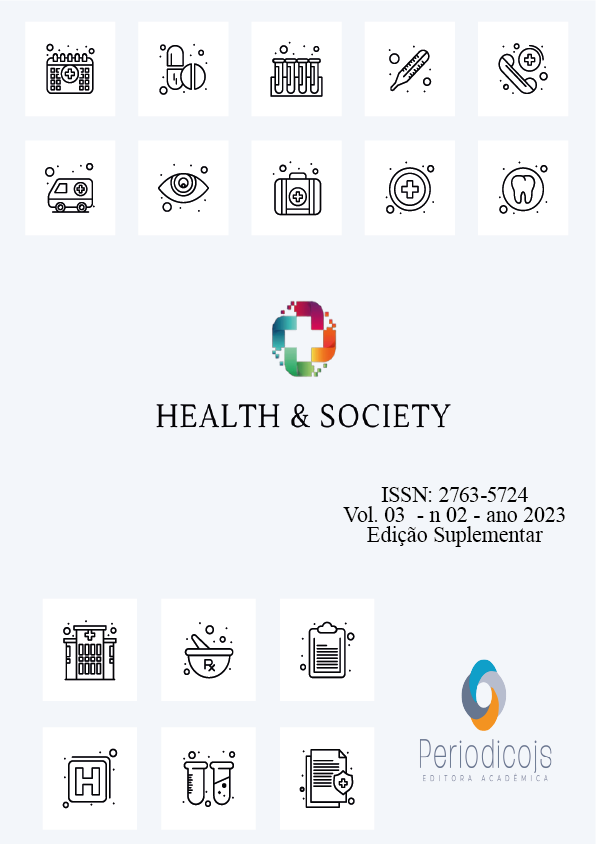Abstract
Introduction: With the arrival of the Covid-19 pandemic in Brazil and the high mortality rates, health service authorities ended up neglecting cases of syphilis, leaving this problem in the background as if the disease were not of such importance to this period. In this sense, the lack of screening, diagnosis and the lack of compulsory notification, left the population more exposed and vulnerable both to the progression of the disease and to the increase in the transmission of syphilis. Objective: To compare the incidence of cases of acquired syphilis and maternal syphilis before and during the Covid-19 pandemic, as well as to highlight the reflection of the coronavirus in the notification and clinical management of the disease. Methodology: This study was carried out through a cross-sectional analysis, whose purpose was the collection and interpretation of data that cover the epidemiological data of reported cases of syphilis before and during Covid-19. Data collection took place between July and December 2022 using the Notifiable Diseases Information System - SINAN and the Unified Health System Database - DATASUS, where the collected data are concentrated between 2018 and 2021 referring to the states of Brazil. Results and Discussion: It is important to highlight that in cases of maternal syphilis, there was a decline in notification in the year 2021, specifically in the second half. These outcomes show a correlation with Table 1, where it is noted that the confirmation of cases of acquired syphilis also had a decline in the same period of 2021. On the other hand, the literature is complemented with the findings in the databases of the System of Grievance Information. Thus, it is noted that the screening, diagnosis and treatment of syphilis is still very complex and involves other factors that relate to the public power. Conclusion: It was possible to highlight the main factors that influence the clinical diagnosis, being the isolation measures, the high rates of infection as well as the low personal demand for medical services where the moment to prioritize the level of attention is mainly focused on the symptom and suppression of the spread of the coronavirus.
References
ARANDIA, Jéssica Cardoso et al. Sífilis na gestação e fatores que dificultam o tratamento na Atenção Primária: revisão integrativa. Revista Eletrônica Acervo Enfermagem, v. 23, n. 1, p. e11557-e11557, 2023.
BACKI, Ana Luiza Gay; PEREIRA, Luiz Carlos Gomes; LOCATELLI, Claudriana. Incidência de sífilis na gestação antes e durante a pandemia da COVID-19 no estado de Santa Catarina e sua relação com o IDH. Research, Society and Development, v. 11, n. 15, p. e248111537239-e248111537239, 2022.
CARVALHO, Matheus Claudino et al. Mudanças de incidência e classificações clínicas da sífilis em gestantes pela pandemia do COVID-19. Research, Society and Development, v. 11, n. 4, p. e35411427433-e35411427433, 2022.
DOMINGUES, Carmen Silvia Bruniera et al. Sífilis e sífilis congênita em tempos de COVID-19. BEPA. Boletim Epidemiológico Paulista, v. 17, n. 201, p. 65-75, 2020.
FIGUEIREDO, Daniela Cristina Moreira Marculino de et al. Relação entre oferta de diagnóstico e tratamento da sífilis na atenção básica sobre a incidência de sífilis gestacional e congênita. Cadernos de Saúde Pública, v. 36, 2020.
FORMIGOSA, Caio de Araújo Corrêa; BRITO, Caio Vinícius Botelho; NETO, Oscar Sampaio Mello. Impacto da COVID-19 em doenças de notificação compulsória no Norte do Brasil. Revista Brasileira em Promoção da Saúde, v. 35, p. 11-11, 2022.
FURLAM, Tiago de Oliveira et al. Efeito colateral da pandemia de Covid-19 no Brasil sobre o número de procedimentos diagnósticos e de tratamento da sífilis. Revista Brasileira de Estudos de População, v. 39, 2022.
GARBIN, Cléa Adas Saliba et al. Sífilis na gravidez: perfil e fatores sociodemográficos associados na Região Noroeste do Estado de São Paulo. Saud Pesq, v. 14, n. 3, p. e7772, 2021.
LIMA, Haroldo Dutra et al. O impacto da pandemia da Covid-19 na incidência de sífilis adquirida no Brasil, em Minas Gerais e em Belo Horizonte. Revista Eletrônica Acervo Saúde, v. 15, n. 8, p. e10874-e10874, 2022.
MAIA, Isabela Mendes et al. A pandemia da COVID-19 como limitador do rastreio das infecções sexualmente transmissíveis no semiárido do Piauí. Research, Society and Development, v. 12, n. 2, p. e19612240101-e19612240101, 2023.
PIRES, Maria Eduarda De Almeida et al. A incidência dos casos de sífilis gestacional ao longo dos anos da pandemia do Covid-19 no Estado do Mato Grosso. Seminários de Biomedicina do Univag, v. 6, 2022.
RESENDE, Karla Pereira et al. A incidência da sífilis congênita no município de Itumbiara, Goiás, no período de 2015 a 2020: possíveis impactos da pandemia causada pelo SARS-CoV-2. Research, Society and Development, v. 11, n. 8, p. e11911829471-e11911829471, 2022.
SALES, Flaviane de Oliveira. Sífilis congênita: uma pandemia além da Covid-19. Repositório Anima Educação. 2022.
VALENTIM, Ricardo et al. Sífilis: resposta a partir de abordagens por múltiplas dimensões. Repositório UFRN. 2023.

This work is licensed under a Creative Commons Attribution 4.0 International License.
Copyright (c) 2023 Cicera Eduarda Almeida de Souza, Iago Gouvea do Carmo e Silva, Leandro Vaz da Silva Borges, Paulo da Costa Araújo, Francisca Maêdya Fernandes Cruz, Karoline Costa Silva, Milena Melo de Souza, Larissa Rodrigues de Sousa, Mariel Wágner Holanda Lima, Tamires Costa Duarte





